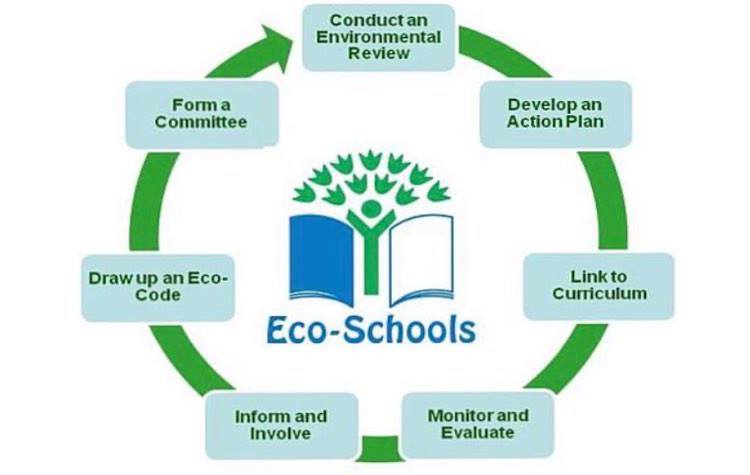
SEVEN STEPS TOWARDS AN ECO-SCHOOL
The Eco-Schools Seven Steps methodology is universal for all Eco-Schools around the globe, currently in 68 countries. The seven steps is a series of carefully engineered measures to help schools maximise the success of their Eco-School ambitions. The method involves a wide diversity of individuals from the school community - with students playing a primary role in the process.
The most important aspect for schools to remember is that every school is different and it is therefore critical that a school fits the seven steps around its circumstances and situation and NOT try to fit the school into the seven steps. Some key points about the individual steps are below.
Step 1: Form an Eco Committee
The Eco-Schools Committee is the driving force behind the Eco-Schools process and will represent the ideas of the whole school.
It is student-led
The Eco Committee ensures that the entire school knows about Eco-Schools and will receive regular updates
Composition can be: Students/Teachers/The Principal/Non-Teaching Staff (e.g. Secretary, Caretaker, Cleaner)/Parents/Members of the Board of Management/interested and relevant members of the wider community
The Eco Committee meets regularly to discuss environmental and social actions for the school
2: Carry out a Sustainability Audit
Carrying out a Sustainability Audit helps the school to identify its current environmental and social impact and highlights the good, the bad and the ugly.
The aim is to investigate the environmental and social issues in your school/community.
All main themes should be reviewed annually (the school is free to also choose other areas of concern that are more relevant to its needs and to devise appropriate checklists accordingly)
Make sure that the wider school community works as closely as possible with the Eco Committee to carry out the Review. It is essential that as many pupils as possible participate in this process
The results of your Sustainability Audit will inform your Action Plan
3: Action Plan
The Action Plan is the core of your Eco-Schools work and should be developed using the results of your Sustainability Audit.
Use the Sustainability Audit to identify the priority areas in your school. To keep it manageable we suggest focusing on not more than three Themes at a time.
Create an Action Plan to resolve or improve those problems. It should include: the necessary tasks, the people responsible and time frame for actions in order to achieve your goals/targets
Make your action plan SMART (specific, measurable, attainable, realistic and timely)
As with every aspect of the Eco-Schools process, pupils should be involved as much as possible in the drawing up of the Action Plan.
4: Monitor and Evaluate
To find out whether or not you are successfully achieving the targets set out in your Action Plan, you must monitor and measure your progress.
As always, pupils should be given the responsibility for carrying out monitoring activities wherever possible
Results of monitoring should be regularly updated and displayed for the whole school to see
The monitoring methods that you use will depend on the targets and measurement criteria decided on in your Action Plan for the topics you wish to look at and the age and ability of the pupils and other individuals who carry it out
Evaluation follows on from monitoring. Evaluating the success of your activities will allow you to make changes to your Action Plan if required.
5: Curriculum Work
Besides increasing the status of the programme, linking Eco-Schools activities to the curriculum ensures that Eco-Schools is truly integrated within the school community.
Integrating the programme into the curriculum can be done, either directly through specific classes or innovative teaching
Pupils from throughout the school should gain an understanding of how real life environmental and social issues are dealt with in a real life setting
6: Inform and Involve
Getting everyone on board! Actions should not just be confined to the school: for example, pupils should take home ideas to put into practice.
It is essential that the whole school is involved in, and the wider community aware of, the schools’ Eco-Schools programme.
Means of information provision and public relations to tell about their work can include: school assemblies, school notice boards, school newsletters and websites, school plays, dramas and fashion shows based on environmental and social issues, letters to businesses and corporations, local and national press, radio and television, etc.
Global Action Days
7: Produce an Eco Code
A statement that represents the school's commitment to sustainability
It should be memorable and familiar to everyone in the school
The format is flexible, it can be a song, drawing, model, poem, etc.
The Eco-Code should list the main objectives of your Action Plan
It is crucial that pupils play a key role in the development of the Eco Code, as this will give them a greater sense of responsibility towards the values the Eco Code represents
The content of the Eco Code should be reviewed on a regular basis to ensure that it continues to reflect the school's ecological aims and targets
The Eco Code should be prominently displayed throughout the school
The Green Flag
Usually after two years of implementing the programme and reaching a high level of performance in complying with these seven steps (sometimes national mandatory criteria also applies), schools can then apply for and be awarded the Green Flag.
Before receiving their first Green Flag, schools must be assessed by means of a visit. After the first Green Flag, other means of assessment are allowed, although visits are always recommended. Assessment should be carried out on a yearly basis.